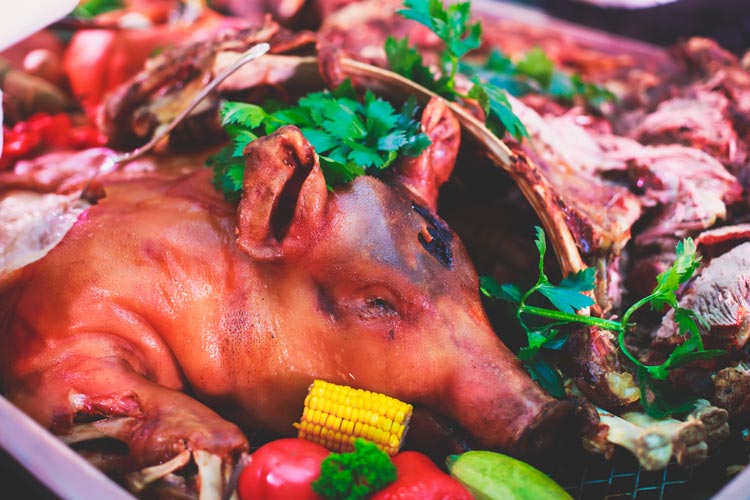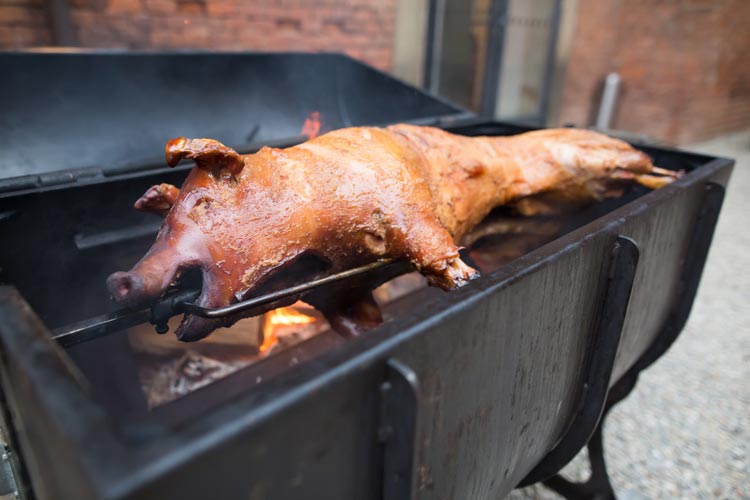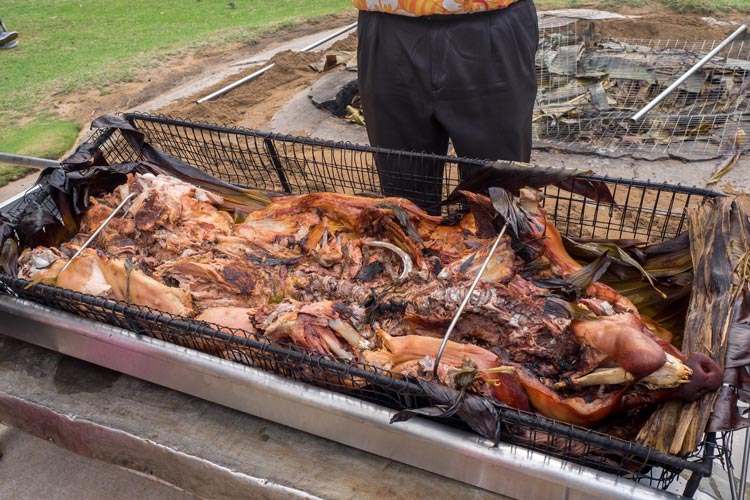Roasting Pig Recipes



Southern French Fig-Stuffed Roast Sucking Pig
What you will need:
- A suckling pig (about 10 to 12 lb)
- A box of coarse salt
- Olive oil, about 3 or 4 tbsp plus extra for basting
- A bottle of rosé or rich white wine, more if needed
- 1 lb chard leaves – thick stems removed, boiled for a few seconds, rinsed in cold water, drained and chopped.
- 12 oz old, firm bread, crust removed, soaked in milk and squeezed so that it is almost dry
- 4 oz young, fresh goat cheese (chevre)
- 4 oz ricotta cheese
- 2 eggs
- 12 oz fresh figs, chopped coarsely
- 4 oz walnuts, chopped
- 2 cloves, ground to a powder
- Freshly grated nutmeg, a pinch
- Additional salt and pepper
- Optional: Additional pork fat from the butcher
How to prepare it:
1. The day before cooking, pour abundant coarse salt all over the pig, inside and out, and rub in to all surfaces. Place in a large tray and leave overnight in your refrigerator or other cool place.
2. The next day, discard the liquid which has accumulated in the tray and wipe the suckling pig dry with towels.
3. While your fire pit is being prepared, prepare the stuffing for the pig. Mash together the eggs and cheeses in a large bowl. Add the walnuts, figs, chard, milk-soaked bread pieces, cloves, nutmeg and salt and pepper and mix all the ingredients together thoroughly with your hands.
4. After trussing the whole pig to the rotisserie spit securely (but not yet set over the fire pit!) and before lacing up the chest and abdominal cavity, push the stuffing into the pig’s chest cavity and then the abdominal cavity.
5. Lace up the abdominal opening securely and truss the legs.
6. With a sharp paring knife make superficial slits in the skin, never cutting all the way through the skin. One cut should go down the back and there should be three or four down each side diagonally from front to back. None of the score marks should cross another. The purpose of this is to prevent the skin from rupturing as the pig cooks and the skin tightens.
7. Rub all over with olive oil and wrap pieces of aluminum foil around the ears and tail to prevent their burning. These can be removed a few minutes before the roast suckling pig is done.
8. If cooking in an oven, the pig’s own fat will collect in the roasting pan and, combined with the wine, makes a good basting liquid. However, when roasting over an open fire or charcoal the fat falls into the fire and cannot easily be collected. Instead, if you are able to get extra pork fat from your butcher, this can be rendered in a pan and then combined with warm wine to create a suitable basting mixture. If no fat is available, olive oil and/or melted butter mixed with the warmed-up wine can substitute. Keep this mixture warm, near boiling.
9. Check that the temperature at the level that the roast suckling pig will be is around 250 to 350 degrees above your fire pit. A meat thermometer or grill thermometer is good for doing this. If it is much hotter than this, let your heat source burn down a while until the heat is lower. This heat can then be maintained by occasionally adding small amounts of firewood or charcoal. At lower heat (250 to 300 degrees) your roast suckling pig will cook slower, but will end up more tender and evenly cooked). At higher temps it will cook faster but not as well.
10. Secure your spit to the rotisserie and begin it turning.
11. After about 30 minutes or so, begin basting liberally with the pork fat and wine mixture. Baste every 10 to 20 minutes. Over time this will help develop a rich, glazed appearance to the skin.
12. Continue cooking in this manner, basting regularly and occasionally tending the fire to maintain even and constant heat, for about 3 to 3 and a half hours. This cooking time will depend on the heat of your fire pit as well as the size of your roast suckling pig. Therefore, this number can vary quite dramatically. If in question, you can check the internal temperature in the deepest parts of the meat and in the chest cavity with a meat thermometer. Pork should reach about 150 to 160 degrees at least to be finished.
13. When done, remove your spit from your rotisserie and set the roast suckling pig aside to rest for about 30 minutes. Then place in a large platter and remove all the trussing twine and the spit. Your roast suckling pig is now ready to be carved and served!
Brined Roast Suckling Pig
This is one of my favorite brine solutions for pork. I also use it to brine other cuts such as brined pork tenderloin. It does have a fairly intense sweet apple flavor so if you prefer a more mellow flavor for your roast you can use less apple cider, salt and/or sugar. However, the high salt solution really helps to intensify the flavors of the meat and to help keep the meat tender and juicy. Also, I particularly like the apple flavor with pork (even better if you use some apple wood to smoke the roast!) but you can certainly use other fruit flavors. One excellent option is a citrus based brine with lemons, oranges and orange juice for the brine and basting liquid. Experiment and see what you like!
What you will need:
For the Brine (make as many batches of this as needed to completely cover your suckling pig):
- 8 cups apple cider
- 7 cups water
- 1 cup coarse sea salt
- 1 cup packed brown sugar
- 6 tbsp coarsely ground black pepper
- 4 tsp dried rubbed sage
- 2 tsp ground cinnamon
- Large onion, cut up
- Apples pieces
- Dash of ground cayenne pepper
- A suckling pig (about 10 to 12 lb.)
- Olive oil
- Optional: additional pork fat from the butcher
- Several additional apples, onions and sage leaves, chopped coarsely
- Salt and pepper
- Additional apple cider for basting
- A bottle of rosé or rich white wine, more if needed
-
How to prepare it:
1. One or two days before cooking, prepare the brine solution. Stir thoroughly to make sure all the salt and sugar are completely dissolved. Make enough to completely cover your suckling pig in a large pot or other container. For very large roasts you can find very large boiling pots or whole turkey fryers at kitchen supply shops. For even bigger roasts, you can use a new, cleaned plastic trash can.
2. Reserve the brining pig in a cool place for about 24 hours or more.
3. On the day of cooking, remove the pig from the brine and pat dry with towels.
4. Make several superficial slits in the skin, not through the skin completely to prevent the skin from rupturing as it cooks. Make one long slit down the back and several diagonal slits on each side. None of the slits should touch any other.
5. Rub the pig with olive oil on all its surfaces.
6. Truss the suckling pig to your rotisserie spit.
7. Fill the body cavities with coarsely chopped apples, onions and sage leaves seasoned with salt and pepper. Close the body cavity securely with twine.
8. If cooking in an oven, the pig’s own fat will collect in the roasting pan and, combined with the wine and apple cider, makes a good basting liquid. However, when roasting over an open fire or charcoal the fat falls into the fire and cannot easily be collected. Instead, if you are able to get extra pork fat from your butcher, this can be rendered in a pan and then combined with warm wine and cider to create a suitable basting mixture. If no fat is available, olive oil and/or melted butter mixed with the warmed-up wine and cider can substitute. Keep this mixture warm, near boiling.
9. Check that the temperature at the level that the roast suckling pig will be is around 250 to 350 degrees above your fire pit. A meat thermometer or grill thermometer is good for doing this. If it is much hotter than this, let your heat source burn down a while until the heat is lower. This heat can then be maintained by occasionally adding small amounts of firewood or charcoal. At lower heat (250 – 300 degrees) your roast suckling pig will cook slower, but will end up more tender and evenly cooked). At higher temps it will cook faster but not as well.
10. Place the spit on your rotisserie over the fire pit and begin cooking.
11. After about 30 minutes or so, begin basting liberally with the pork fat and wine mixture. Baste every 10 to 20 minutes. Over time this will help develop a rich, glazed appearance to the skin.
12. Continue cooking in this manner, basting regularly and occasionally tending the fire to maintain even and constant heat, for about 3 to 3 and a half hours. This cooking time will depend on the heat of your fire pit as well as the size of your roast suckling pig. Therefore, this number can vary quite dramatically. If in question, you can check the internal temperature in the deepest parts of the meat and in the chest cavity with a meat thermometer. Pork should reach about 150 to 160 degrees at least to be finished.
13. When done, remove your spit from your rotisserie and set the roast suckling pig aside to rest for about 30 minutes. Then place in a large platter and remove all the trussing twine and the spit.
Your roast suckling pig is now done and can be presented at table and carved carefully. I recommend first removing the shoulder and hind-legs at the joints. These pieces then can be sliced to serve. Next make a cut down the middle of the back, down the the spine. Carefully cut from the shoulder cut, hugging the bone of the ribs and spine, down to where the hams (rump and hind-leg) were removed. This large piece will include the rack and loin cuts as well as the pork belly. It can be sliced crossways to serve. The meat between the ribs can also be freed and the stuffing can be scooped out. Enjoy!
Simple Hog Rub
What you will need:
For each pound of pork:
- 6 tablespoons garlic salt
- 6 tablespoons paprika
- 4 tablespoons sugar
- 3 tablespoons onion salt
- 2 tablespoons brown sugar
- 2 tablespoons chili powder
- 6 tablespoons salt
- 2 tablespoons cayenne pepper
- 2 tablespoons cumin
- 4 tablespoons black pepper
- 1 tablespoon coriander
How to prepare it:
1. To prepare, lay the whole hog on its back on a flat table. With a small pair of handheld pruning shears, cut each rib bone as close to the spine as possible. This allows the hog to be spread out and lay flat (butterfly). When a hog is “butterflied” like this, it reduces the cooking time, enables each piece of meat to be cooked evenly, and makes seasoning the meat easier and uniform. With a sharp knife, score the top of each ham and shoulder with a cut about 1 inch deep to allow better heat penetration.
2. Season the belly of the hog with 2 cups of the dry rub. Work the rub into all crevices and make sure that all exposed meat is seasoned thoroughly.
3. Flip the hog over so that the skin is facing up. Coat the skin with olive oil. This helps generate a beautiful mahogany skin color during the cooking process.
Marinade for a Cuban Mojo Sauce
This is one of my favorite brine solutions for pork. I also use it to brine other cuts such as brined pork tenderloin. It does have a fairly intense sweet apple flavor so if you prefer a more mellow flavor for your roast you can use less apple cider, salt and/or sugar. However, the high salt solution really helps to intensify the flavors of the meat and to help keep the meat tender and juicy. Also, I particularly like the apple flavor with pork (even better if you use some apple wood to smoke the roast!) but you can certainly use other fruit flavors. One excellent option is a citrus based brine with lemons, oranges and orange juice for the brine and basting liquid. Experiment and see what you like!
What you will need:
- 8 ounces lemon juice
- 16 ounces pineapple juice
- 24 ounces orange juice
- 16 ounces water
- 16 teaspoons salt
- 4 tablespoons oregano
- 4 garlic bulbs
- 4 teaspoons cumin
- 4 tablespoons bay leaves
How to prepare it:
1. Always inject your marinade to infuse the flavors into the meat. Inject on the pig’s shoulders and hams liberally but be careful not to make too many holes in it.
2. When you’re done injecting the mojo sauce, you have to turn the pig over and apply the sauce on its skin, too. Rub the pig skin with the adobo seasoning afterwards to make it tastier.
3. If you’re using sweet ingredients in your marinade or seasoning, make sure that you’ll apply it when the pig is almost done. You can also put the sweet ingredients inside the pig instead of applying them on the skin. If you leave the sweet marinade in the heat for too long, it will eventually burn and give your pig a bitter taste.
4. Never ditch the rub. Some people miss this part and just go with the marinade solely. If you want to impress your loved ones and friends with your pig roast, take the time to rub it with a great seasoning. To make sure that the herbs and spices will stick to the pig, you should apply the sauce first followed by the rub. On the other hand, other barbecue lovers apply yellow mustard instead.
